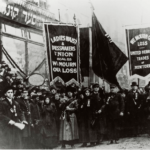Students will explore and discuss the history and context around the Juneteenth holiday. Topics examined include the history of racial injustice in the U.S., the Civil War and the limitations of the Emancipation Proclamation. Additionally, students will be encouraged to explore the modern significance of Juneteenth and its long-term impact.
At George Washington’s Mount Vernon, Remembering the Enslaved People Who Built America
A tour guide at Washington’s Mount Vernon estate, who is also a distant relation of an enslaved person at the Virginia estate, offers his perspective about American history, slavery and the founding fathers.
Aftermath of the War on Terror
This 11-minute video and lesson plan enable students to examine the experiences of Muslims and Arab Americans following the terrorist attacks of 9/11. Students will investigate one example of a flawed prosecution of Arab immigrants living in Detroit as a case study in the climate of fear following the attacks. Students will then choose from among other primary source materials to describe particular experiences and generalize about the broader experiences of Muslims and Arab Americans.
From Women’s Suffrage to the ERA
This seven-minute video and accompanying lesson plan looks at how throughout the 1960’s and 70’s the second wave feminism movement worked to address gender inequality across the United States. While the movement had several important victories, the Equal Rights Amendment was not passed. Was the second wave feminist movement a success nonetheless?
Black History Month Lesson Plans on Nonviolence
The power of nonviolent actions and attitudes as a means to resist oppression and spur reforms is a recurring feature of democratic and democratizing societies. The School Violence Prevention Demonstration Program presents educators with lesson plans that explore the use of nonviolence in history, paying particular attention to the civil rights movement and African American history. Six lessons address: the 1963 Children’s March; the concept of nonviolence using primary sources and stories of participants in the civil rights movement; the power of nonviolence; the story of Rosa Parks; citizenship schools; how music can be used to achieve social and political change.
Competing Voices of the Civil Rights Movement
When most people think of the Civil Rights Movement in America, they think of Martin Luther King, Jr. delivering his “I Have a Dream” speech on the steps of the Lincoln Memorial in 1963 and receiving the Nobel Peace Prize the following year. But “the Movement” achieved its greatest results — the 1964 Civil Rights Act and the 1965 Voting Rights Act — due to the competing strategies and agendas of diverse individuals. Even black Americans, the primary beneficiaries of this landmark legislation, did not agree on the tactics that should be used to secure the equal protection of their rights. This unit presents the views of several important black leaders who shaped the debate over how to achieve freedom and equality in a nation that had long denied a portion of the American citizenry the full protection of their rights.
The Vietnam War Lesson Guide
Explore classroom lesson plans related to Ken Burns’s and Lynn Novick’s 10-part, 18-hour documentary series, The Vietnam War, which tells the story of one of the most consequential, divisive and controversial events in American history. The series explores the human dimensions of the war through the testimony of nearly 80 witnesses from all sides.
Labor Day: Union Education Resources

Share My Lesson has curated a collection of free lesson plans, activities, and resources to help teachers explore labor history with their K-12 students. Students will learn about the meaning of Labor Day, labor history, how Labor Day got its name, how labor unions work, and how labor unions have impacted the course of history.
Democracy Corps: A Complete Service Learning Program
Learn about American democracy while serving your community. Serve your community while learning about the responsibilities of American democracy. YLI’s Democracy Corps brings your civics lessons to the community while instilling life- long civic engagement in your students.
U.S. Courts: Women’s History Month
The federal courts observe Women’s History Month by celebrating women’s education and accomplishments. Find inspiring profiles of women who made federal court history and inspired others to succeed and watch first-person videos of contemporary women who serve on the federal bench today.